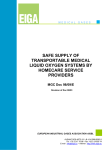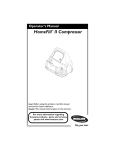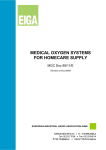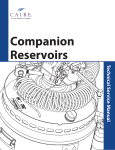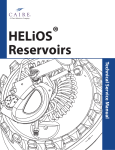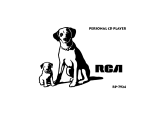Download OPERATING INSTRUCTIONS AND INSPECTION
Transcript
OPERATING INSTRUCTIONS AND INSPECTION GUIDELINES FOR ALUMINUM CYLINDER PORTABLE MEDICAL OXYGEN THERAPY SYSTEM IMPORTANT PLEASE READ THOROUGHLY AND FOLLOW DIRECTIONS CAREFULLY BEFORE OPERATING EQUIPMENT. TABLE OF CONTENTS SAFETY SIGNAL WORD DEFINITIONS .............................................3 WARRANTY..........................................................................................3 THE PORTABLE OXYGEN THERAPY SYSTEM ................................4 WARNINGS ...................................................................................... 4-5 ASSEMBLY AND FILLING INSTRUCTIONS ................................... 6-7 POST FILL INSPECTION .....................................................................7 SET-UP FOR OPERATION ..................................................................8 OPERATION .........................................................................................8 INSPECTION AND FLOW VERIFICATION TESTING .........................9 REPAIRS (after Warranty period) ....................................................... 10 CLEANING.......................................................................................... 11 HANDLING.......................................................................................... 11 STORAGE........................................................................................... 11 CYLINDER REPLACEMENT.............................................................. 11 APPENDIX A: WESTERN XR FLOW CHECK PROCESS USING WESTERN MTA-300 LITER METER................................ 12-13 NOTE TO DRUG MANUFACTURER ................................................. 14 2 SAFETY SIGNAL WORDS Statements in this manual preceded by the following safety signal words are of special significance. Definitions of the SAFETY signal words: DANGER Means a hazard that will cause death or serious injury if the warning is ignored. WARNING Means a hazard that could cause death or serious injury if the warning is ignored. CAUTION Means a hazard that may cause minor or moderate injury if the warning is ignored. It also means hazard that will cause damage to property. NOTE Indicates points of particular interest for more efficient and convenient operation. WARRANTY Components of this system are warranted under use against any and all manufacturing defects from the date of purchase for six (6) years. Other components are covered by their manufacturers’ warranties. Any failure resulting from defective parts or faulty workmanship, as determined during evaluation by the manufacturer, will be repaired under warranty. This warranty will be null and void for any unit that has been subject to misuse, negligence, accident, or repairs other than those performed by Western Medica and/or an agreed upon alternate repair facility. 3 THE PORTABLE OXYGEN THERAPY SYSTEM Portable medical oxygen systems are designed to provide additional mobility with a self-contained supply of oxygen. The basic system consists of a cylinder with the regulator mounted and pressurized with oxygen (as filled) and a cannula, mask, or some other device to transfer the oxygen from the unit to the patient. Please refer to the instructions supplied with the cannula or mask for their proper use. Oxygen regulators are pressure reducing devices that lower the oxygen pressure from cylinder pressure to a level that can be safely used by the patient. When it is necessary to control and monitor the amount of oxygen being delivered, a flow type regulator is utilized. These regulators can be used with a variety of user delivery devices including cannula and mask that are specially designed for use with this equipment. This system is designed to require minimal maintenance and is not adjustable. The portable medical oxygen system can be used for emergency use only when administered by properly trained personnel for oxygen deficiency and resuscitation. CAUTION Federal law prohibits dispensing without prescription. WARNING This unit is an inhalator and is useful only to persons who are breathing. On apneic (non-breathing) persons, use resuscitation to restore breathing prior to administering oxygen. Keep cylinder, regulator, all equipment, and connections free of oil, grease, or other combustible materials to avoid violent ignition. When filled, oxygen will be under pressure and can vigorously accelerate combustion if allowed to come in contact with oil, grease, or other hydrocarbons. Use only equipment and apparatus designed and cleaned for use with oxygen. Items not compatible with and cleaned for oxygen service may ignite or contaminate the system. Use of high concentrations of oxygen for extended lengths of time should be avoided without first consulting a physician. DO NOT smoke in the area where oxygen is in use. Oxygen enriched areas may ignite causing personal injury of property damage. 4 WARNING (Continued) DO NOT attempt to operate this equipment unless you have been trained in its proper use or under competent supervision. DO NOT use or store near heat or flame. DO NOT expose to direct sunlight for long periods of time or any condition where temperature is above 130° F. DO NOT attempt to service or remove the regulator from the cylinder. Improper servicing the product may create conditions for the regulator or cylinder to propel with great force. DO NOT throw cylinder into fire or incinerator. Federal laws requires that the cylinder be filled or refilled with U.S.P. (United States Pharmacopoeia) grade oxygen, only by establishments registered as drug producers or repackers in accordance with the Federal Drug and Cosmetic Act. Oxygen is a non-flammable gas; it will however substantially increase the rate at which flammable materials burn. Oil, grease, and other hydrocarbons when combined with oxygen, will become highly combustible and therefore should never be used on any part of the oxygen cylinder, regulator, or other equipment used with oxygen. Do not use with masks and cannula designed for use with gas powered equipment. This device also contains several safety features that will relieve pressure if a system malfunction occurs. A relief rupture disc will prevent excess pressure from building up in the high pressure cylinder and is manufactured in accordance with Compressed Gas Association specifications set forth in CGA pamphlet S.1.1. A regulator bleed hole will also relieve pressure in case of a regulator malfunction either intermittently or continuously. In any case, the system should be turned off immediately, removed from service, placed outdoors, and the equipment supplier notified. DO NOT lubricate regulator. Unapproved lubricants could contaminate system creating conditions for combustion. Keep out of reach of children. Setting the knob between flow positions will result in a no flow condition. 5 NOTE Backpressure in excess of 2 psi will cause inaccuracy of the delivery flow rate. Common causes of back pressure are kinked hoses or hoses under 3/16 inch in diameter I.D. and over twenty feet in length between the regulator outlet and user or any restrictions to flow occurring in that area. Operating Temperature Range: -4° to 122° F (-20°C to 50°C) ASSEMBLY AND FILLING INSTRUCTIONS Assembly of Regulator to Cylinder 1. Remove filler valve cap, front cover, and rear cover. Note how the covers fit into the grooves on the regulator. 2. Remove two dust caps. One is located on the outlet, and the other is on the regulator cylinder threads. Discard cylinder thread dust cap. 3. Install Teflon o-ring on regulator. 4. Thread regulator into cylinder and tighten to a torque of 80-90 ft-lbs. 5. Place front cover and rear cover into grooves of regulator. 6. Install five screws through rear cover and tighten. NOTE Do not attempt to fill cylinders unless you are familiar with the regulations and procedures established to properly handle and fill cylinders with medical gases. Filling Procedure The following are additional items that must be followed to fill this specific product. All other aspects of transfilling shall be conducted to meet all FDA and CGA guidelines. (Cylinder inspection, purity test, etc.) 1. Attach pigtail to filler valve. Evacuate cylinder. Slowly fill cylinder to cylinder’s working pressure. WARNING DO NOT exceed fill rate of 200 psig / minute. NOTE Flow indicator knob should be in the “OFF” position during filling. Center “OFF” above pressure gauge. If leakage around cylinder threads occurs, stop the filling process and inspect regulator for proper installation and evidence of Teflon o-rings installed. 6 2. Once cylinder is filled, and prior to removing filler valve nut, pressure to the cylinder must be stopped from the fill manifold using a shut-off valve or other means. A pressure will still exist between the shut-off valve and the cylinder being filled. The cylinder valve nut has a bleed hole built in to relieve the pressure when the cylinder valve nut is backed off (use rapid even motion) approximately 1/2 turn. When pressure is released and diminished, the check valve in the filler valve closes maintaining the full pressure in the cylinder. A pressure drop of 30 to 60 psi is required to close the check valve. At this point the cylinder valve nut can be completely removed safely. 3. Check regulator-to-cylinder thread connection for leakage using oxygen compatible leak test solution. 4. Install fill port cap wrench snug following completion of fill process leak check(s). POST FILL INSPECTION Immediately after assembly and initial pressurization of system, inspect highpressure areas for leaks using oxygen compatible leak test solution. Check the following areas: Cylinder threads Pressure gauge Filler valve Burst disc Outlet Weep hole under outlet If a leak occurs at cylinder threads, blow down cylinder, evacuate cylinder, and inspect for proper installation of regulator Reinstall regulator with new o-ring and follow assembly and filling instructions. If a leak occurs at any other area, remove regulator from cylinder and return regulator to supplier. CAUTION Do not attempt to repair unit. Otherwise warranty is void. Personal injury may result from improper assembly. NOTE Leak testing is to be performed during every system transfill for entire life of the product. 7 SET-UP FOR OPERATION 1. Support and secure the system in some manner to keep it from falling or rolling over. 2. Inspect the inlet and outlet of the regulator for traces of dirt, dust, oil or grease. Dirt or dust can be removed safely with a lint-free cloth. CAUTION If oil or grease is visible or suspected do not use the system. Inform the gas or equipment supplier of this condition immediately. Do not attempt to clean or repair the regulator. Have the system service by qualified personnel. Personal injury or property damage may result due to ignition. If any leakage of the oxygen is detected be sure the flow adjusting knob is turned counter-clockwise to the “OFF” position. If leakage persists, immediately place the cylinder outdoors and notify the gas supplier. 3. With the regulator outlet facing away from you, turn the flow adjusting knob clockwise to purge any undetectable debris from the regulator outlet fitting, then turn the flow adjusting knob counter-clockwise to “OFF”. 4. Attach the oxygen supply tubing (cannula or other delivery device) to the regulator’s barbed outlet connection located inside the housing access hole on the right side. OPERATION To turn system “ON”, turn the flow adjusting knob clockwise from the “OFF” position. For general oxygen therapy applications, adjust the knob to the flow prescribed by your physician. For safety, always turn oxygen systems on slowly. Secure oxygen system when not in use to prevent tipping of system. Setting the knob between flow positions will result in a no flow condition. Refer to warning label. To turn system “OFF”, turn the flow adjusting knob counter-clockwise to the “OFF” position. To conserve oxygen and for safety, do not let system flow oxygen when not in use. The high pressure gauge on the system indicates the cylinder pressure (contents). The gauge is always on whether the regulator is open or closed. 8 INSPECTION AND FLOW VERIFICATION TESTING Assure that cover is installed properly and is always present. This will protect regulator if it should fall and minimize exposure to contaminants. Periodically inspect the following: Any damage to system Integrity of cover Integrity of cylinder Gauge functions properly Knob does not grind when turned Cleanliness of regulator (i.e. corrosion, debris) Flow rates at each of the respective settings should be verified every 5 years, or more frequently if possible, as recommended in CGA E-7. A product technical data sheet is available from the supplier. If flows do not meet technical specifications, return regulator to supplier. NOTE Western recommends the performance of an annual flow check of the XR systems in accordance with the “Western XR Flow Check Process using Western MTA-300 Liter Meter Systems”, provided in Appendix A of this document. Contact your Western Medica customer service representative to obtain a Western MTA-300 Liter Meter System. CAUTION Do not attempt to repair unit. Otherwise warranty is void. Personal injury may result from improper assembly. 9 REPAIRS (After Warranty Period) If cover or knob should become damaged, contact supplier to purchase replacement parts. If leakage occurs around outlet, weep hole, or top of regulator replace housing assembly. Contact supplier. If knob grinds or does not turn replace housing assembly. Contact supplier. If flows do not meet technical specifications replace piston assembly and housing assembly. Contact supplier for these items. CAUTION Repairs must be made by a qualified medical equipment repair person(s). Proper training is required before any repairs should be attempted. Also product testing is required in accordance with the Production and Test Methods. (Note that these methods are not provided herein) 10 CLEANING If cleaning of the plastic cover is desired, the exterior surfaces can be safely wiped off with a clean, lint-free cloth and water. HANDLING Inherently, portable oxygen systems are subject to more abuse than stationary units. Care must be taken to minimize the abuse a portable oxygen system endures to ensure the accuracy and longevity of your system. One should avoid jarring or dropping systems as this may cause damage to the unit. If a system is jarred, dropped, or knocked over, it should be checked to ensure connections are secure, components are not damaged, and that the proper flow rates are maintained. STORAGE Systems should be stored where they will not fall over or be subjected to damage from objects falling on or against them. Systems should be stored in a sheltered location to protect them from exposure to the elements and excessive moisture. Never store a system in an elevated place. Never store system near heat or open flame. Never store a system in extreme cold conditions. CYLINDER REPLACEMENT A cylinder with less than 500 psi showing on the high-pressure contents gauge should be exchanged for a full cylinder to ensure an adequate supply of oxygen. 11 WESTERN XR FLOW CHECK PROCESS USING WESTERN MTA-300 LITER METER SYSTEMS: APPENDIX A Verify cylinder pressure greater than 2,200 psi. Place Western XR system on test stand or rotate unit on fill rack to orient hose barb in a vertical position. Connect flow measurement hose to outlet barb. Position flow selector knob to 10 liters per minute position. Wait for flow to stabilize. Read indicated flow on liter meter. Compare to Western XR Flow Check Specifications using Western MTA-300 Liter Meter (below). Position flow selector knob to the 15 liters per minute position. Wait for flow to stabilize. Read indicated flow on liter meter. Compare to Western XR Flow Check Specifications using Western MTA-300 Liter Meter (below). Position flow selector knob to 10 liters per minute position. Wait for flow to stabilize. Read indicated flow on liter meter. Compare to Western XR Flow Check Specifications using Western MTA-300 Liter Meter (below). Return flow selector knob to the off position. Remove non-complying units from operational service and contact Western for Warranty service. 12 WESTERN XR FLOW CHECK SPECIFICATIONS WESTERN MTA-300 LITER METER SYSTEMS: APPENDIX A Knob rotation toward increasing flow direction, 10 liters per minute position: Flow must be greater than 7.0 liters per minute as indicated on the liter meter. Knob rotation toward increasing flow direction, 15 liters per minute position: Flow must be greater than 11.0 liters per minute as indicated on the liter meter. Knob rotation in decreasing flow direction, 10 liters per minute position: Flow must be greater than 7.0 liters per minute as indicated on the liter meter. 13 NOTE TO DRUG MANUFACTURER To refill the system, place unit in a well ventilated area or outdoors. Turn flow adjusting knob full-on for bleeding leftover oxygen within the cylinder down to atmospheric pressure. Blow down will take approximately 20 minutes for “E” cylinders that have 500 psi or less and are set a 8 LPM. This must be done before a vacuum can be drawn on the cylinder. When the cylinder is at atmospheric pressure, the check valve in the CGA 540 filler connection is open and the vacuum can then be applied to the cylinder. When filling, the recommended fill rate of oxygen should be limited to a rate of 200 psi per minute. Once the cylinder has been filled with oxygen, the pigtail or transfilling manifold needs to be bled rapidly enough to create a 30 psi pressure drop which assures that the check valve closes. This is easily accomplished by turning the CGA 540 nut on the pigtail one quarter of a turn counter-clockwise with one smooth continuous motion. The check valve is only intended to seal the cylinder pressure until the pressure tight CGA 540 cap can be installed. This should be done immediately after filling and before shipping. A pressure decay test should verify an acceptable leakage rate or a standard leak test that uses leak detect solution. If further inspection of the regulator is needed, the plastic cover halves are held in place with five #4-19 Phillips Pan Head Plastic screws and can easily be removed, or the units can be inspected through the shroud access holes. 14 15 B20415 ECN-14137 (0801)

















